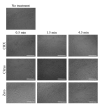The Effects of Various Mouthwashes on Osteoblast Precursor Cells
- PMID: 33817172
- PMCID: PMC7874790
- DOI: 10.1515/biol-2019-0042
The Effects of Various Mouthwashes on Osteoblast Precursor Cells
Abstract
This study examined whether or not various mouthwashes have significant effects on the viability or morphology of mouse osteoblast-like cells. Mouse calvarial preosteoblast cells were cultured and prepared, then treated with a 0.12% chlorhexidine digluconate solution containing essential oils with or without alcohol, and a cetylpyridinium chloride solution, and sodium fluoride, respectively. Each well was treated with one of six mouthwashes for either 30 sec, 1.5 min, or 4.5 min. The viability of the treated cells was quantitatively analyzed by a Cell Counting Kit-8. The viability of osteogenic progenitor cells decreased significantly irrespectively of the types of mouthwashes. The changes of cell morphology were seen in all groups of mouthwashes; however, they were more noticeable on the chlorhexidine digluconate-treated group. A progressive increase in treatment time over 30 sec did not seem to deteriorate cellular viability. There was no significant difference in viability or morphological change between different formulations of the same brand. Although various mouthwashes without alcohol as an ingredient are available, nonalcoholic mouthwashes were not likely to be less harmful to the cells. Collectively, commercially available mouthwashes could inhibit cell viability and alter the morphology of osteoblastic precursor cells irrespectively of brands, treatment time, or alcohol content.
Keywords: cell survival; mouthwashes; osteoblasts.
© 2019 In-Seok Song et al., published by De Gruyter.
Conflict of interest statement
Conflict of interest: Authors state no conflict of interest
Figures





Similar articles
-
Evaluation of the Effects of Mouthwash on the Morphology and Cell Viability of Osteoblast-Like Cells.Biomed Res Int. 2022 Feb 4;2022:5884974. doi: 10.1155/2022/5884974. eCollection 2022. Biomed Res Int. 2022. PMID: 35155676 Free PMC article.
-
The Effects of Three Chlorhexidine-Based Mouthwashes on Human Osteoblast-Like SaOS-2 Cells. An In Vitro Study.Int J Mol Sci. 2021 Sep 15;22(18):9986. doi: 10.3390/ijms22189986. Int J Mol Sci. 2021. PMID: 34576150 Free PMC article.
-
Real-Time Analysis of Antiproliferative Effects of Mouthwashes Containing Alcohol, Sodium Fluoride, Cetylpyridinium Chloride, and Chlorhexidine In Vitro.Biomed Res Int. 2021 Oct 12;2021:2610122. doi: 10.1155/2021/2610122. eCollection 2021. Biomed Res Int. 2021. PMID: 34676260 Free PMC article.
-
Antiviral effect of mouthwashes against SARS-COV-2: A systematic review.Saudi Dent J. 2022 Mar;34(3):167-193. doi: 10.1016/j.sdentj.2022.01.006. Epub 2022 Feb 1. Saudi Dent J. 2022. PMID: 35125835 Free PMC article. Review.
-
Charcoal-based mouthwashes: a literature review.Br Dent J. 2020 Feb;228(4):290-294. doi: 10.1038/s41415-020-1265-8. Br Dent J. 2020. PMID: 32112023 Review.
Cited by
-
Evaluation of the Effects of Mouthwash on the Morphology and Cell Viability of Osteoblast-Like Cells.Biomed Res Int. 2022 Feb 4;2022:5884974. doi: 10.1155/2022/5884974. eCollection 2022. Biomed Res Int. 2022. PMID: 35155676 Free PMC article.
-
Effect of dental antiseptic agents on the viability of human periodontal ligament cells.Saudi Dent J. 2021 Dec;33(8):904-911. doi: 10.1016/j.sdentj.2021.09.016. Epub 2021 Sep 14. Saudi Dent J. 2021. PMID: 34938032 Free PMC article.
-
The Therapeutic Potential of Inflamed Gingiva-Derived Mesenchymal Stem Cells in Preclinical Studies: A Scoping Review of a Unique Biomedical Waste.Stem Cells Int. 2021 Feb 10;2021:6619170. doi: 10.1155/2021/6619170. eCollection 2021. Stem Cells Int. 2021. PMID: 33628266 Free PMC article.
-
The Effects of Three Chlorhexidine-Based Mouthwashes on Human Osteoblast-Like SaOS-2 Cells. An In Vitro Study.Int J Mol Sci. 2021 Sep 15;22(18):9986. doi: 10.3390/ijms22189986. Int J Mol Sci. 2021. PMID: 34576150 Free PMC article.
-
Pomegranate Extract Potentiates the Anti-Demineralizing, Anti-Biofilm, and Anti-Inflammatory Actions of Non-Alcoholic Mouthwash When Associated with Sodium-Fluoride Trimetaphosphate.Antibiotics (Basel). 2022 Oct 25;11(11):1477. doi: 10.3390/antibiotics11111477. Antibiotics (Basel). 2022. PMID: 36358132 Free PMC article.
References
-
- Tsourounakis I, Palaiologou-Gallis AA, Stoute D. Effect of essential oil and chlorhexidine mouthwashes on gingival fibroblast survival and migration. J Periodontol. 2013;84:1211–1220. - PubMed
-
- Chen Y, Wong RW, Seneviratne CJ. Comparison of the antimicrobial activity of Listerine and Corsodyl on orthodontic brackets in vitro. Am J Orthod Dentofacial Orthop. 2011;140:537–542. - PubMed
-
- Albert-Kiszely A, Pjetursson BE, Salvil GE. Comparison of the effects of cetylpyridinium chloride with an essential oil mouth rinse on dental plaque and gingivitis - a six-month randomized controlled clinical trial. Journal of Clinical Periodontology. 2007;34:658–667. - PubMed
-
- Costa X, Laguna E, Herrera D. Efficacy of a new mouth rinse formulation based on 0.07% cetylpyridinium chloride in the control of plaque and gingivitis: a 6-month randomized clinical trial. J Clin Periodontol. 2013;40:1007–1015. - PubMed
-
- Haps S, Slot DE, Berchier CE. The effect of cetylpyridinium chloride-containing mouth rinses as adjuncts to toothbrushing on plaque and parameters of gingival inflammation: a systematic review. Int J Dent Hyg. 2008;6:290–303. - PubMed
LinkOut - more resources
Full Text Sources
